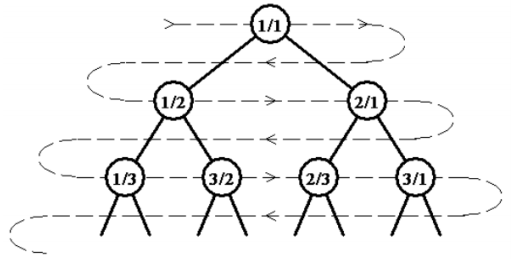Programming contestsACM ICPC programozó csapatverseny, házi forduló, 2016. október 15.
October 15, 2016, 10:00 AM –
October 15, 2016, 3:00 PM
|
A Rational Sequence
A sequence of positive rational numbers is defined as follows:
An infinite full binary tree labeled by positive rational numbers is defined by:
- The label of the root is 1/1.
- The left child of label p/q is p/(p + q).
- The right child of label p/q is (p + q)/q.
The top of the tree is shown in the following figure:

The sequence is defined by doing a level-order (breadth-first) traversal of the tree (indicated by the light dashed line). So that:
F(1) = 1/1, F(2) = 1/2, F(3) = 2/1, F(4) = 1/3, F(5) = 3/2, F(6) = 2/3, …
Write a program which finds the value of n for which F(n) is p/q for inputs p and q.
Input Specification
The first line of the input contains a single integer P (1 ≤ P ≤ 1000), which is the number of data sets that follow. Each data set should be processed identically and independently.
Each data set consists of a single line of input. It contains the data set number K,
a single space, the numerator p, a forward slash (/), and the
denominator q of the desired fraction.
Output Specification
For each data set, there is a single line of output. It contains the data set number K, followed by a single space, which is then followed by the value of n for which F(n) is p/q. Inputs will be chosen so that n will fit in a 32-bit integer.
Sample Input
41 1/12 1/33 5/24 2178309/1346269
Output for Sample Input
1 12 43 114 1431655765